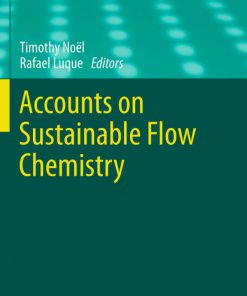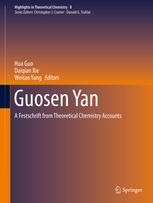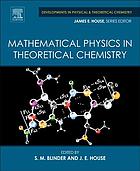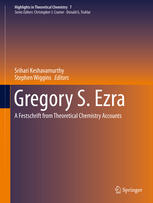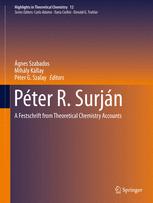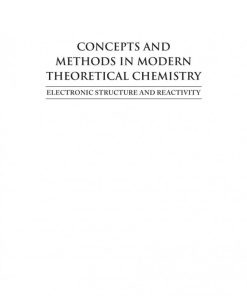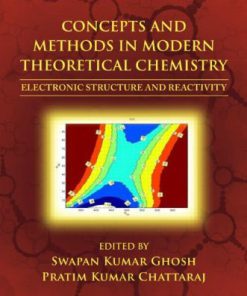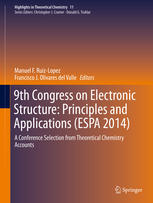Theoretical Chemistry in Belgium A Topical Collection from Theoretical Chemistry Accounts 1st Edition by Benoît Champagne, Michael Deleuze, Frank De Proft, Tom Leyssens 3642413155 9783642413155
$50.00 Original price was: $50.00.$25.00Current price is: $25.00.
Theoretical Chemistry in Belgium A Topical Collection from Theoretical Chemistry Accounts 1st Edition by Benoît Champagne, Michael S. Deleuze, Frank De Proft, Tom Leyssens – Ebook PDF Instant Download/Delivery: 3642413155, 9783642413155
Full download Theoretical Chemistry in Belgium A Topical Collection from Theoretical Chemistry Accounts 1st Edition after payment
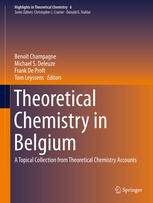
Product details:
ISBN 10: 3642413155
ISBN 13: 9783642413155
Author: Benoît Champagne, Michael S. Deleuze, Frank De Proft, Tom Leyssens
Readers of this volume can take a tour around the research locations in Belgium which are active in theoretical and computational chemistry. Selected researchers from Belgium present research highlights of their work. Originally published in the journal Theoretical Chemistry Accounts, these outstanding contributions are now available in a hardcover print format. This volume will be of benefit in particular to those research groups and libraries that have chosen to have only electronic access to the journal. It also provides valuable content for all researchers in theoretical chemistry.
Theoretical Chemistry in Belgium A Topical Collection from Theoretical Chemistry Accounts 1st table of contents:
1 University of Antwerp
2 Free University of Brussels
2.1 Université Libre de Bruxelles (ULB)
3 Ghent University
3.1 Ghent quantum chemistry group (GQCG)
3.2 Center for Molecular Modeling (CMM)
4 University of Hasselt
5 University of Leuven
6 University of Liège
7 University of Louvain-la-Neuve
8 University of Mons
9 University of Namur
References
Is there an exact potential energy surface?
1 Introduction
2 The mathematics of the Born approach
3 Defining an electronic Hamiltonian
4 The PES from an exact solution?
5 Rotational motion in a polyatomic molecule
6 Removing rotational motion in the frame fixed in the body
7 The separation of electronic and nuclear motion in an embedded frame
8 The permutational invariance of the PES
9 Conclusions
References
Self-consistent methods constrained to a fixed number of particles in a given fragment and its relat
1 Introduction
2 Model
3 Results and discussion
4 Concluding remarks
References
Host–guest and guest–guest interactions between xylene isomers confined in the MIL-47(V) pore sy
1 Introduction
2 Computational methods
2.1 Characterization of a xylene pair
2.2 Quantumchemical modeling
3 Results and discussion
3.1 Guest–guest interactions in gas phase
3.3 Decomposition of adsorption energy in MIL-47
4 Conclusions
References
Laser control in open quantum systems: preliminary analysis toward the Cope rearrangement control in
1 Introduction
2 Chemistry of dimerization
3 Quantum chemistry investigation
4 Model and methods
4.1 System-bath model
4.2 Auxiliary density matrix method
4.3 Optimal control
5 Results
5.1 Control without dissipation
5.2 Stability of the control under dissipation
6 Conclusion
References
Ruthenocene and cyclopentadienyl pyrrolyl ruthenium as precursors for ruthenium atomic layer deposit
1 Introduction
2 Computational details
3 Results and discussion
3.1 Heterolytic dissociation enthalpy of RuCp2 and RuCpPy
3.2 Homolytic dissociation enthalpy of RuCp2 and RuCpPy
4 Conclusions
References
The Boron conundrum: the case of cationic clusters B+n with n = 2–20
1 Introduction
2 Computational methods
3 Results and discussion
3.1 Evaluation of computational methods
3.2 Shape of the low-lying isomers of cationic B+n clusters
3.3 Energetic and thermochemical properties
3.4 Relative stability of clusters
3.5 Dissociation energies (De)
3.6 Electron delocalization and aromaticity of cationicclusters B+n
4 Concluding remarks
References
Quantum chemical study of self-doping PPV oligomers: spin distribution of the radical forms
1 Introduction
2 The FOHI method
3 Computational details
4 Results and discussion
4.1 Geometry and atomic
4.2 Spin distribution and hyperfine coupling
5 Conclusion
References
Electron momentum spectroscopy of metal carbonyls: a reinvestigation of the role of nuclear dynamics
1 Introduction
2 Theory
3 Methodology
4 Results and discussion
5 Conclusions
References
Radical electrophilicities in solvent
1 Introduction
2 Computational details
3 Results and discussion
3.1 Electronic chemical potential
3.2 Chemical hardness
3.3 Global electrophilicity index
3.4 Local electrophilicity index, condensed to the radical center
4 Conclusions
References
S5 graphs as model systems for icosahedral Jahn–Teller problems
1 Introduction
2 S5 graphs
3 The complete 5-vertex graph K5 and the fourfold degeneracy
4 The Petersen graph and the fivefold degeneracy
5 The 20-vertex graph and the sixfold degeneracy
6 Conclusions
References
Mechanism of ketone hydrosilylation using NHC–Cu(I) catalysts: a computational study
1 Introduction
2 Computational details
3 Results and discussion
3.1 Activation of the pre-catalyst
3.2 Catalytic cycle
4 Conclusions
References
From atoms to biomolecules: a fruitful perspective
1 Introduction
2 Theoretical atomic spectroscopy
3 Bridging atomic physics and quantum chemistry
3.1 Brillouin’s theorem
3.2 The treatment of one-electron non-orthogonalities
3.3 B-spline basis sets
4 Ab initio characterization of molecular structures
4.1 Determination of accurate molecular equilibrium properties
4.2 Excited electronic structure of transition metal containing diatomics
4.3 Intermolecular potential energy surfaces of acetylene–rare gas complexes
5 Non-adiabatic wavepacket molecular dynamics
6 Quantum chemical calculations of biomolecules and their environment
6.1 Isolated DNA bases and DNA base clusters
6.2 DNA intercalating complexes
6.3 Influence of the DNA environment
7 A fruitful perspective
References
Stabilization of merocyanine by protonation, charge, and external electric fields and effects on the
1 Introduction
2 Computational methodology
3 Thermal isomerization of the neutral
4 Field effects on the neutral reaction pathway
5 O and N protonation effects
6 Electron attachment and ionization effects
7 Concluding remarks
References
Ewald-type formulas for Gaussian-basis studies of one-dimensionally periodic systems
1 Introduction
2 Total energy—basic formulas
3 Nuclear–nuclear term
4 Singularity cancellation
5 Convergence rates
6 Numerical tests
7 Conclusions
References
Smoothed Gaussian molecular fields: an evaluation of molecular alignment problems
1 Introduction
2 Theoretical background
3 Applications and results
3.1 Alignment results for the elastase TOMI/DFKi system
3.2 Alignment results for the endothiapepsin ligands
3.3 Alignment results for the trypsin ligands
3.4 Alignment results for the thermolysin ligands
3.5 Alignment results for the p38 ligands
3.6 Alignment results for the HRV14 ligands
4 Conclusions
5 Online resources
References
Ab initio quantum chemical and ReaxFF-based study of the intramolecular iminium–enamine conversion
1 Introduction
2 Computational methods
3 Results and discussion
3.1 Comparison of QM methods
3.2 Conformational issues
3.3 Solvation effects
3.4 Validation of the FF
3.5 ReaxFF MD simulations
4 Conclusions
References
Density functional theory for the description of charge-transfer processes at TTF/TCNQ interfaces
1 Introduction
2 Theoretical results
2.1 Isolated molecules
2.2 Isolated stacks
2.3 TTF/TCNQ complex
2.4 Large TTF/TCNQ stacks
2.5 Two-dimensional interfaces
3 Conclusions
References
Implementation in the Pyvib2 program of the localized mode method and application to a helicene
1 Introduction
2 Vibrational normal modes and IR, Raman, VCD, and ROA intensities
3 Localization of vibrational normal modes
4 Computational aspects
5 Localized mode method using pyvib2
5.1 Determination of the normal mode ensemble
5.2 Localized mode procedure
6 Conclusions and outlook
References
Time-dependent density functional theory study of charge transfer in collisions
1 Introduction
2 Theoretical background
3 Proton impacting Helium
4 Gold–Butane collision
5 Conclusions
References
A simple DFT-based diagnostic for nondynamical correlation
1 Introduction and background
2 Methods
3 Results and discussion
4 Conclusions
References
Electronic structure analysis of small gold clusters Aum (m ≤16)
1 Introduction
Metal clusters are molecular-like entities, formed by assembling a small number of atoms ranging fro is some symmetry more stable than others? What are the rules governing the geometry of the most stab
2 Methodology and results
3 Discussion
3.1 Dimer Au2
3.2 Closed-shell systems
3.2.1 Au4: σ–σ* interaction
3.2.2 Au6 and Au8: σ aromaticity
3.2.3 Higher nuclearities: structural transition
3.3 Open-shell systems
3.3.1 Au3: the “push pull” effect
3.3.2 Au5: competition between resonance structures
3.3.3 Higher nuclearities
4 Conclusions
References
Combining molecular dynamics with Monte Carlo simulations: implementations and applications
1 Introduction
2 Accelerated molecular dynamics techniques
2.1 Temperature-accelerated dynamics
2.2 Hyperdynamics
3 Combining MD and MC simulations
3.1 Setting the scene: Monte Carlo simulations
3.2 Combined MD/MC algorithms
3.2.1 Mixed MD/MC algorithm
3.2.2 Hybrid algorithms
3.2.3 Sequential algorithms: alternating MD and MC
3.2.4 Sequential algorithms: alternating hybrid algorithms
4 Examples of combined MD/MC
4.1 Hybrid algorithms: Cu surface diffusion by tfMC
4.2 Alternating MD and MC: (U)NCD growth by MD/MMC
4.3 Alternating hybrid algorithms: CNT growth by MD/fbMC
5 Conclusion
People also search for Theoretical Chemistry in Belgium A Topical Collection from Theoretical Chemistry Accounts 1st:
chemistry belgium
belgium chemistry university
theoretical chemistry
belgium molecule structure
berkeley theoretical chemistry
Tags: Theoretical Chemistry, Belgium A Topical, Collection, Theoretical Chemistry, Accounts, Benoît Champagne, Michael Deleuze, Frank De Proft, Tom Leyssens
You may also like…
Science (General)
Chemistry
Isaiah Shavitt: A Memorial Festschrift from Theoretical Chemistry Accounts 1st Edition Ron Shepard




